PESTEL Analysis as a Strategic Marketing Tool for Business
VerifiedAdded on 2023/06/11
|8
|2227
|277
Report
AI Summary
This report provides a critical analysis of PESTEL as a strategic management tool, emphasizing its use in evaluating external marketing variables that determine a firm's success. It explores the historical context of PESTEL analysis, tracing its evolution from the ETPS framework to the current PESTEL model, which encompasses political, economic, social, technological, environmental, and legal factors. The report highlights how PESTEL helps businesses understand and adapt to external market conditions. It then applies the PESTEL framework to a case study involving DJI's potential entry into the South African market, analyzing the political, economic, and technological environments to assess the viability of the business venture. The analysis considers factors such as government policies, economic growth, technological advancements, and market competition to provide insights into the strategic implications for DJI. The report underscores the importance of understanding the macro-economic environment for informed business decisions and strategic planning.
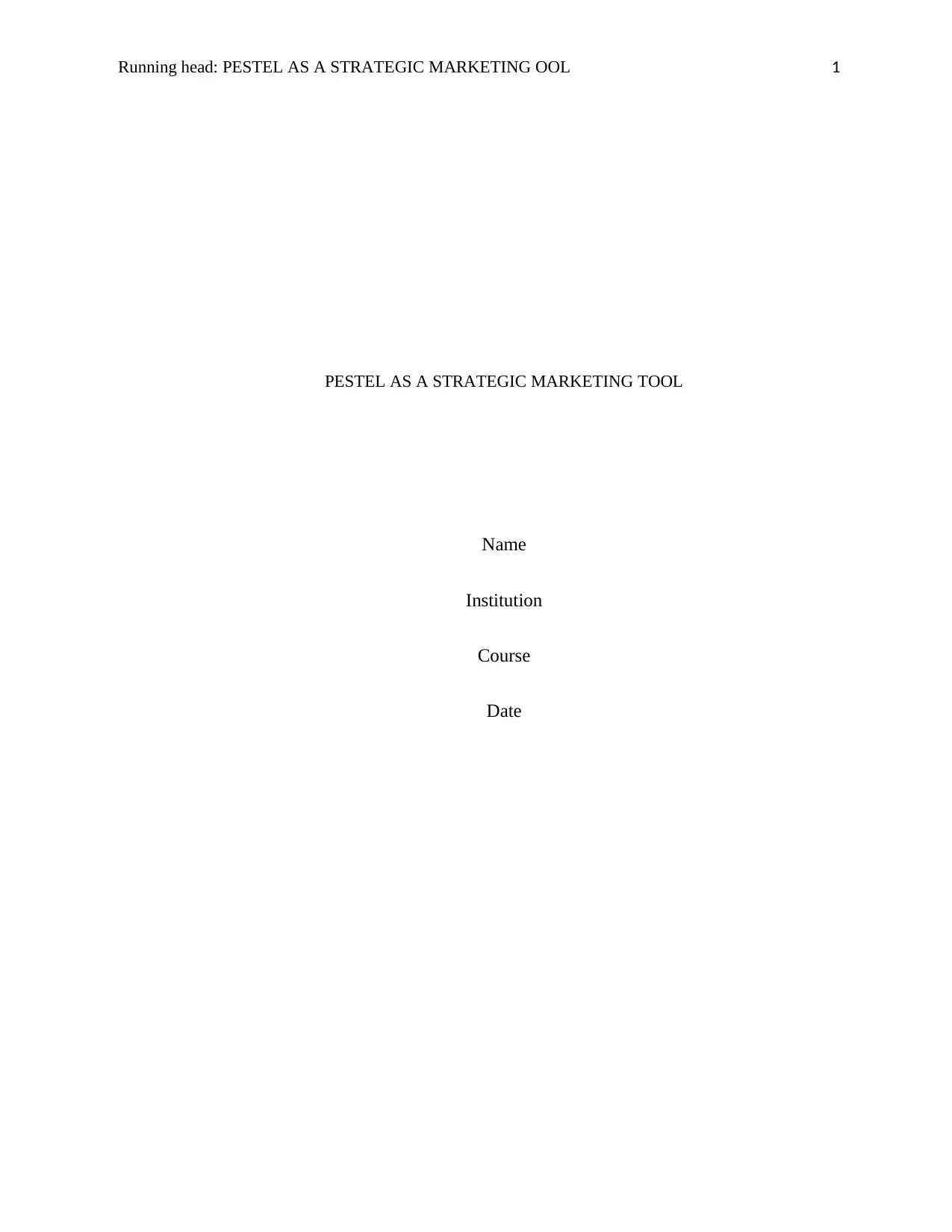
Running head: PESTEL AS A STRATEGIC MARKETING OOL 1
PESTEL AS A STRATEGIC MARKETING TOOL
Name
Institution
Course
Date
PESTEL AS A STRATEGIC MARKETING TOOL
Name
Institution
Course
Date
Secure Best Marks with AI Grader
Need help grading? Try our AI Grader for instant feedback on your assignments.
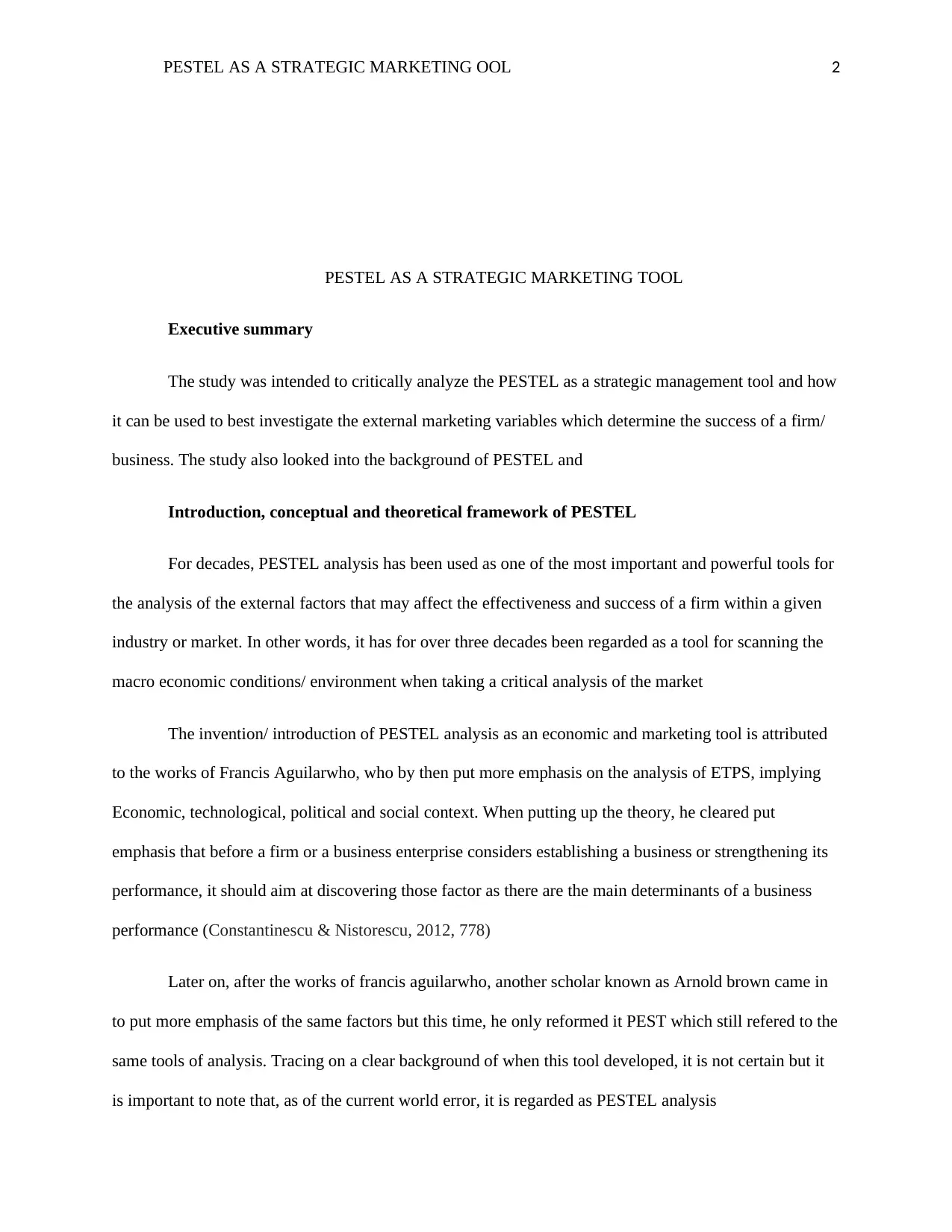
PESTEL AS A STRATEGIC MARKETING OOL 2
PESTEL AS A STRATEGIC MARKETING TOOL
Executive summary
The study was intended to critically analyze the PESTEL as a strategic management tool and how
it can be used to best investigate the external marketing variables which determine the success of a firm/
business. The study also looked into the background of PESTEL and
Introduction, conceptual and theoretical framework of PESTEL
For decades, PESTEL analysis has been used as one of the most important and powerful tools for
the analysis of the external factors that may affect the effectiveness and success of a firm within a given
industry or market. In other words, it has for over three decades been regarded as a tool for scanning the
macro economic conditions/ environment when taking a critical analysis of the market
The invention/ introduction of PESTEL analysis as an economic and marketing tool is attributed
to the works of Francis Aguilarwho, who by then put more emphasis on the analysis of ETPS, implying
Economic, technological, political and social context. When putting up the theory, he cleared put
emphasis that before a firm or a business enterprise considers establishing a business or strengthening its
performance, it should aim at discovering those factor as there are the main determinants of a business
performance (Constantinescu & Nistorescu, 2012, 778)
Later on, after the works of francis aguilarwho, another scholar known as Arnold brown came in
to put more emphasis of the same factors but this time, he only reformed it PEST which still refered to the
same tools of analysis. Tracing on a clear background of when this tool developed, it is not certain but it
is important to note that, as of the current world error, it is regarded as PESTEL analysis
PESTEL AS A STRATEGIC MARKETING TOOL
Executive summary
The study was intended to critically analyze the PESTEL as a strategic management tool and how
it can be used to best investigate the external marketing variables which determine the success of a firm/
business. The study also looked into the background of PESTEL and
Introduction, conceptual and theoretical framework of PESTEL
For decades, PESTEL analysis has been used as one of the most important and powerful tools for
the analysis of the external factors that may affect the effectiveness and success of a firm within a given
industry or market. In other words, it has for over three decades been regarded as a tool for scanning the
macro economic conditions/ environment when taking a critical analysis of the market
The invention/ introduction of PESTEL analysis as an economic and marketing tool is attributed
to the works of Francis Aguilarwho, who by then put more emphasis on the analysis of ETPS, implying
Economic, technological, political and social context. When putting up the theory, he cleared put
emphasis that before a firm or a business enterprise considers establishing a business or strengthening its
performance, it should aim at discovering those factor as there are the main determinants of a business
performance (Constantinescu & Nistorescu, 2012, 778)
Later on, after the works of francis aguilarwho, another scholar known as Arnold brown came in
to put more emphasis of the same factors but this time, he only reformed it PEST which still refered to the
same tools of analysis. Tracing on a clear background of when this tool developed, it is not certain but it
is important to note that, as of the current world error, it is regarded as PESTEL analysis
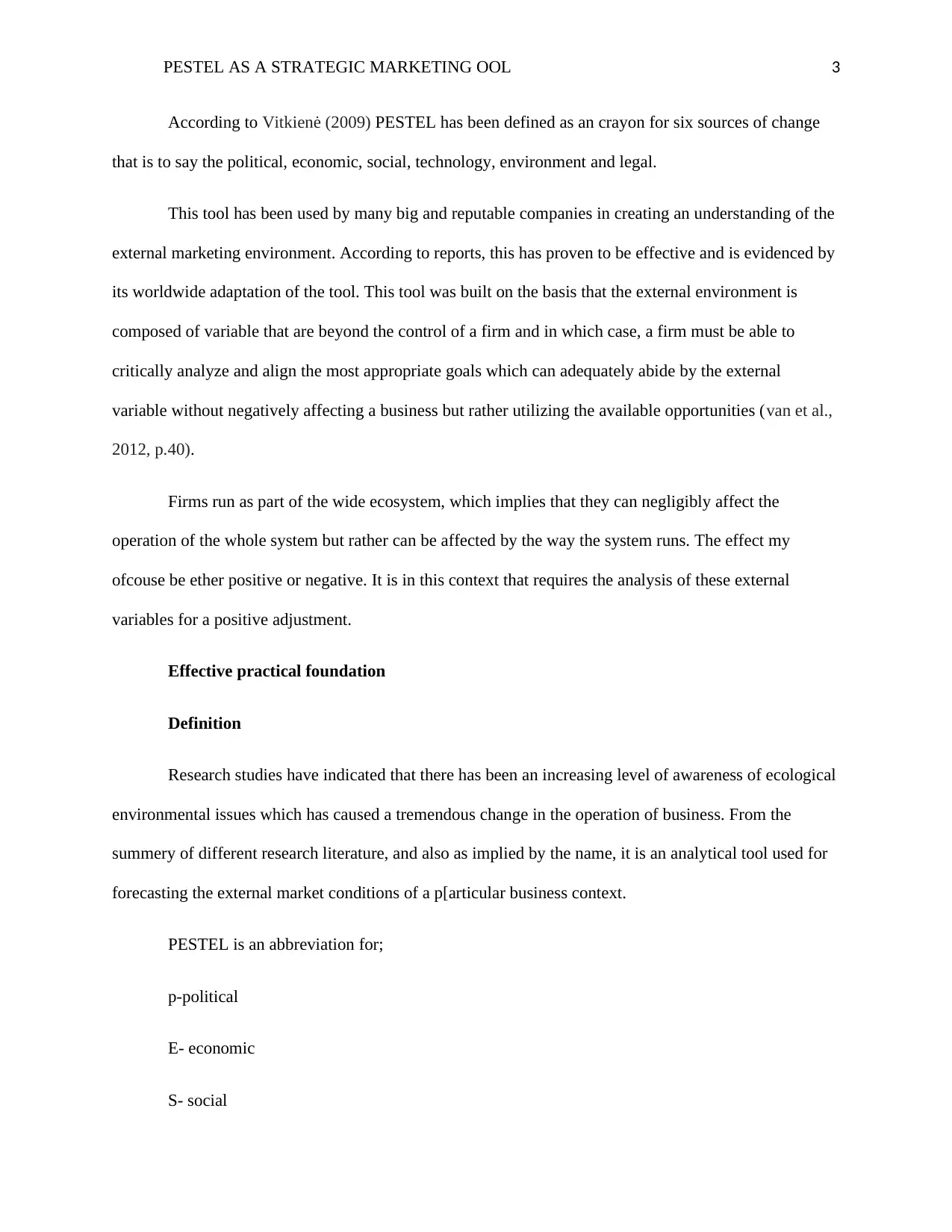
PESTEL AS A STRATEGIC MARKETING OOL 3
According to Vitkienė (2009) PESTEL has been defined as an crayon for six sources of change
that is to say the political, economic, social, technology, environment and legal.
This tool has been used by many big and reputable companies in creating an understanding of the
external marketing environment. According to reports, this has proven to be effective and is evidenced by
its worldwide adaptation of the tool. This tool was built on the basis that the external environment is
composed of variable that are beyond the control of a firm and in which case, a firm must be able to
critically analyze and align the most appropriate goals which can adequately abide by the external
variable without negatively affecting a business but rather utilizing the available opportunities (van et al.,
2012, p.40).
Firms run as part of the wide ecosystem, which implies that they can negligibly affect the
operation of the whole system but rather can be affected by the way the system runs. The effect my
ofcouse be ether positive or negative. It is in this context that requires the analysis of these external
variables for a positive adjustment.
Effective practical foundation
Definition
Research studies have indicated that there has been an increasing level of awareness of ecological
environmental issues which has caused a tremendous change in the operation of business. From the
summery of different research literature, and also as implied by the name, it is an analytical tool used for
forecasting the external market conditions of a p[articular business context.
PESTEL is an abbreviation for;
p-political
E- economic
S- social
According to Vitkienė (2009) PESTEL has been defined as an crayon for six sources of change
that is to say the political, economic, social, technology, environment and legal.
This tool has been used by many big and reputable companies in creating an understanding of the
external marketing environment. According to reports, this has proven to be effective and is evidenced by
its worldwide adaptation of the tool. This tool was built on the basis that the external environment is
composed of variable that are beyond the control of a firm and in which case, a firm must be able to
critically analyze and align the most appropriate goals which can adequately abide by the external
variable without negatively affecting a business but rather utilizing the available opportunities (van et al.,
2012, p.40).
Firms run as part of the wide ecosystem, which implies that they can negligibly affect the
operation of the whole system but rather can be affected by the way the system runs. The effect my
ofcouse be ether positive or negative. It is in this context that requires the analysis of these external
variables for a positive adjustment.
Effective practical foundation
Definition
Research studies have indicated that there has been an increasing level of awareness of ecological
environmental issues which has caused a tremendous change in the operation of business. From the
summery of different research literature, and also as implied by the name, it is an analytical tool used for
forecasting the external market conditions of a p[articular business context.
PESTEL is an abbreviation for;
p-political
E- economic
S- social
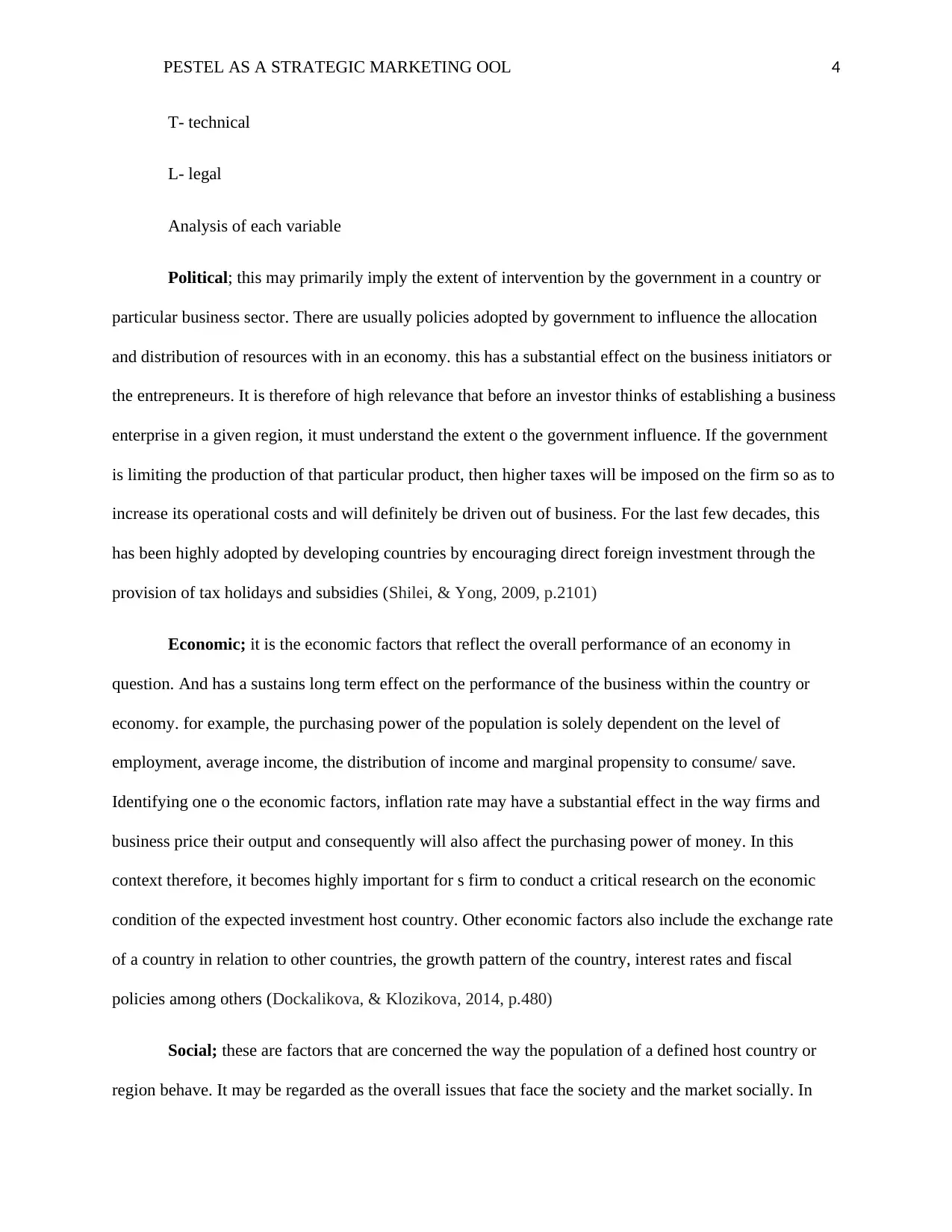
PESTEL AS A STRATEGIC MARKETING OOL 4
T- technical
L- legal
Analysis of each variable
Political; this may primarily imply the extent of intervention by the government in a country or
particular business sector. There are usually policies adopted by government to influence the allocation
and distribution of resources with in an economy. this has a substantial effect on the business initiators or
the entrepreneurs. It is therefore of high relevance that before an investor thinks of establishing a business
enterprise in a given region, it must understand the extent o the government influence. If the government
is limiting the production of that particular product, then higher taxes will be imposed on the firm so as to
increase its operational costs and will definitely be driven out of business. For the last few decades, this
has been highly adopted by developing countries by encouraging direct foreign investment through the
provision of tax holidays and subsidies (Shilei, & Yong, 2009, p.2101)
Economic; it is the economic factors that reflect the overall performance of an economy in
question. And has a sustains long term effect on the performance of the business within the country or
economy. for example, the purchasing power of the population is solely dependent on the level of
employment, average income, the distribution of income and marginal propensity to consume/ save.
Identifying one o the economic factors, inflation rate may have a substantial effect in the way firms and
business price their output and consequently will also affect the purchasing power of money. In this
context therefore, it becomes highly important for s firm to conduct a critical research on the economic
condition of the expected investment host country. Other economic factors also include the exchange rate
of a country in relation to other countries, the growth pattern of the country, interest rates and fiscal
policies among others (Dockalikova, & Klozikova, 2014, p.480)
Social; these are factors that are concerned the way the population of a defined host country or
region behave. It may be regarded as the overall issues that face the society and the market socially. In
T- technical
L- legal
Analysis of each variable
Political; this may primarily imply the extent of intervention by the government in a country or
particular business sector. There are usually policies adopted by government to influence the allocation
and distribution of resources with in an economy. this has a substantial effect on the business initiators or
the entrepreneurs. It is therefore of high relevance that before an investor thinks of establishing a business
enterprise in a given region, it must understand the extent o the government influence. If the government
is limiting the production of that particular product, then higher taxes will be imposed on the firm so as to
increase its operational costs and will definitely be driven out of business. For the last few decades, this
has been highly adopted by developing countries by encouraging direct foreign investment through the
provision of tax holidays and subsidies (Shilei, & Yong, 2009, p.2101)
Economic; it is the economic factors that reflect the overall performance of an economy in
question. And has a sustains long term effect on the performance of the business within the country or
economy. for example, the purchasing power of the population is solely dependent on the level of
employment, average income, the distribution of income and marginal propensity to consume/ save.
Identifying one o the economic factors, inflation rate may have a substantial effect in the way firms and
business price their output and consequently will also affect the purchasing power of money. In this
context therefore, it becomes highly important for s firm to conduct a critical research on the economic
condition of the expected investment host country. Other economic factors also include the exchange rate
of a country in relation to other countries, the growth pattern of the country, interest rates and fiscal
policies among others (Dockalikova, & Klozikova, 2014, p.480)
Social; these are factors that are concerned the way the population of a defined host country or
region behave. It may be regarded as the overall issues that face the society and the market socially. In
Secure Best Marks with AI Grader
Need help grading? Try our AI Grader for instant feedback on your assignments.
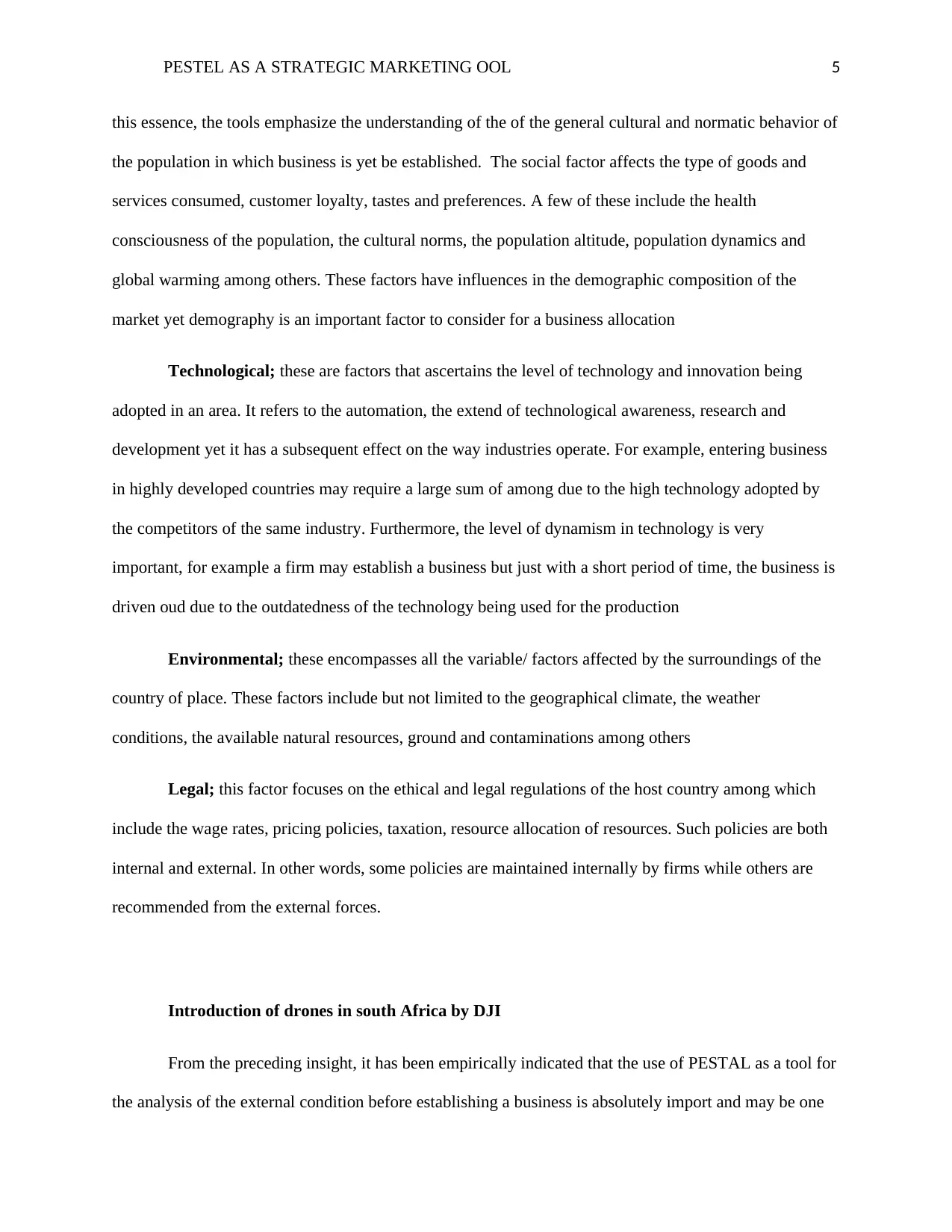
PESTEL AS A STRATEGIC MARKETING OOL 5
this essence, the tools emphasize the understanding of the of the general cultural and normatic behavior of
the population in which business is yet be established. The social factor affects the type of goods and
services consumed, customer loyalty, tastes and preferences. A few of these include the health
consciousness of the population, the cultural norms, the population altitude, population dynamics and
global warming among others. These factors have influences in the demographic composition of the
market yet demography is an important factor to consider for a business allocation
Technological; these are factors that ascertains the level of technology and innovation being
adopted in an area. It refers to the automation, the extend of technological awareness, research and
development yet it has a subsequent effect on the way industries operate. For example, entering business
in highly developed countries may require a large sum of among due to the high technology adopted by
the competitors of the same industry. Furthermore, the level of dynamism in technology is very
important, for example a firm may establish a business but just with a short period of time, the business is
driven oud due to the outdatedness of the technology being used for the production
Environmental; these encompasses all the variable/ factors affected by the surroundings of the
country of place. These factors include but not limited to the geographical climate, the weather
conditions, the available natural resources, ground and contaminations among others
Legal; this factor focuses on the ethical and legal regulations of the host country among which
include the wage rates, pricing policies, taxation, resource allocation of resources. Such policies are both
internal and external. In other words, some policies are maintained internally by firms while others are
recommended from the external forces.
Introduction of drones in south Africa by DJI
From the preceding insight, it has been empirically indicated that the use of PESTAL as a tool for
the analysis of the external condition before establishing a business is absolutely import and may be one
this essence, the tools emphasize the understanding of the of the general cultural and normatic behavior of
the population in which business is yet be established. The social factor affects the type of goods and
services consumed, customer loyalty, tastes and preferences. A few of these include the health
consciousness of the population, the cultural norms, the population altitude, population dynamics and
global warming among others. These factors have influences in the demographic composition of the
market yet demography is an important factor to consider for a business allocation
Technological; these are factors that ascertains the level of technology and innovation being
adopted in an area. It refers to the automation, the extend of technological awareness, research and
development yet it has a subsequent effect on the way industries operate. For example, entering business
in highly developed countries may require a large sum of among due to the high technology adopted by
the competitors of the same industry. Furthermore, the level of dynamism in technology is very
important, for example a firm may establish a business but just with a short period of time, the business is
driven oud due to the outdatedness of the technology being used for the production
Environmental; these encompasses all the variable/ factors affected by the surroundings of the
country of place. These factors include but not limited to the geographical climate, the weather
conditions, the available natural resources, ground and contaminations among others
Legal; this factor focuses on the ethical and legal regulations of the host country among which
include the wage rates, pricing policies, taxation, resource allocation of resources. Such policies are both
internal and external. In other words, some policies are maintained internally by firms while others are
recommended from the external forces.
Introduction of drones in south Africa by DJI
From the preceding insight, it has been empirically indicated that the use of PESTAL as a tool for
the analysis of the external condition before establishing a business is absolutely import and may be one
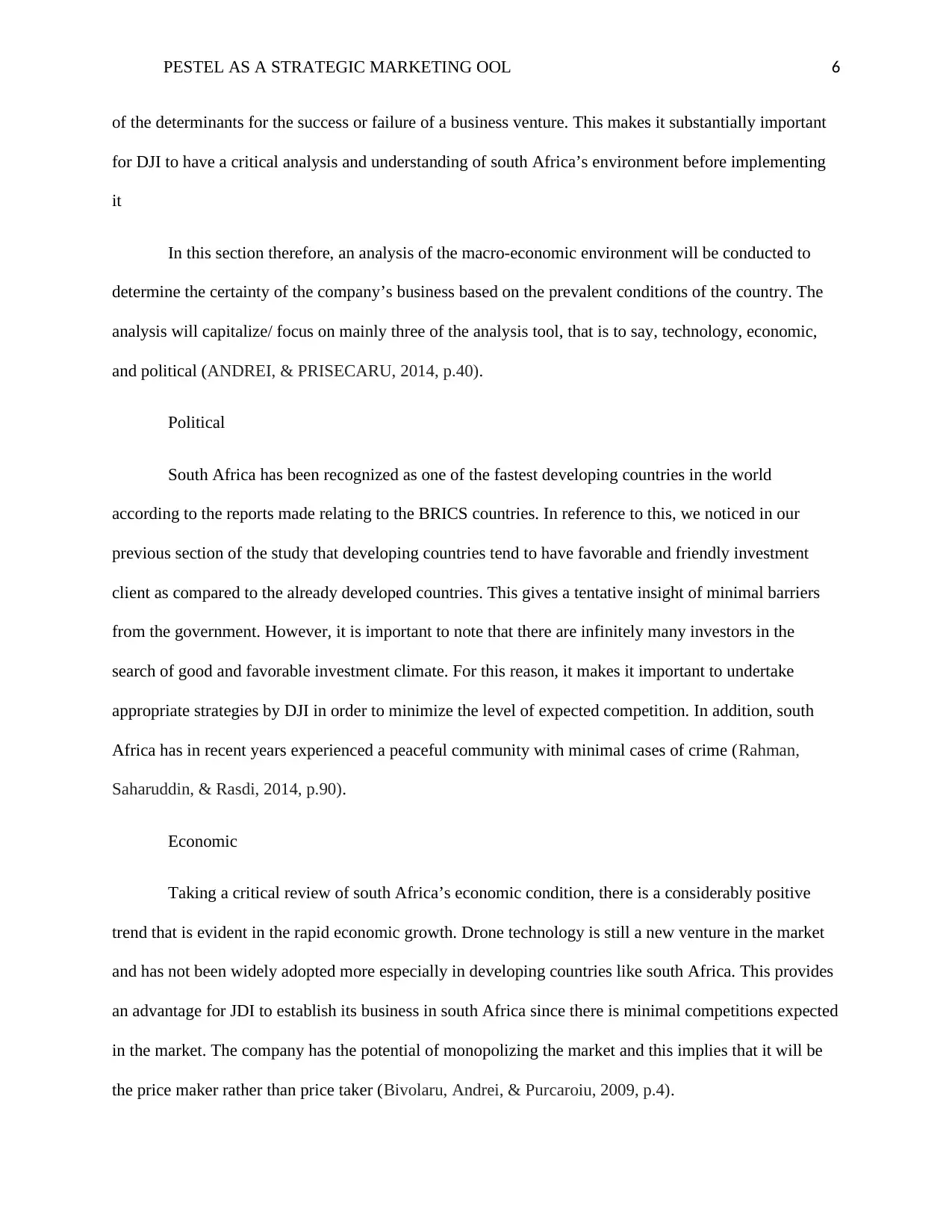
PESTEL AS A STRATEGIC MARKETING OOL 6
of the determinants for the success or failure of a business venture. This makes it substantially important
for DJI to have a critical analysis and understanding of south Africa’s environment before implementing
it
In this section therefore, an analysis of the macro-economic environment will be conducted to
determine the certainty of the company’s business based on the prevalent conditions of the country. The
analysis will capitalize/ focus on mainly three of the analysis tool, that is to say, technology, economic,
and political (ANDREI, & PRISECARU, 2014, p.40).
Political
South Africa has been recognized as one of the fastest developing countries in the world
according to the reports made relating to the BRICS countries. In reference to this, we noticed in our
previous section of the study that developing countries tend to have favorable and friendly investment
client as compared to the already developed countries. This gives a tentative insight of minimal barriers
from the government. However, it is important to note that there are infinitely many investors in the
search of good and favorable investment climate. For this reason, it makes it important to undertake
appropriate strategies by DJI in order to minimize the level of expected competition. In addition, south
Africa has in recent years experienced a peaceful community with minimal cases of crime (Rahman,
Saharuddin, & Rasdi, 2014, p.90).
Economic
Taking a critical review of south Africa’s economic condition, there is a considerably positive
trend that is evident in the rapid economic growth. Drone technology is still a new venture in the market
and has not been widely adopted more especially in developing countries like south Africa. This provides
an advantage for JDI to establish its business in south Africa since there is minimal competitions expected
in the market. The company has the potential of monopolizing the market and this implies that it will be
the price maker rather than price taker (Bivolaru, Andrei, & Purcaroiu, 2009, p.4).
of the determinants for the success or failure of a business venture. This makes it substantially important
for DJI to have a critical analysis and understanding of south Africa’s environment before implementing
it
In this section therefore, an analysis of the macro-economic environment will be conducted to
determine the certainty of the company’s business based on the prevalent conditions of the country. The
analysis will capitalize/ focus on mainly three of the analysis tool, that is to say, technology, economic,
and political (ANDREI, & PRISECARU, 2014, p.40).
Political
South Africa has been recognized as one of the fastest developing countries in the world
according to the reports made relating to the BRICS countries. In reference to this, we noticed in our
previous section of the study that developing countries tend to have favorable and friendly investment
client as compared to the already developed countries. This gives a tentative insight of minimal barriers
from the government. However, it is important to note that there are infinitely many investors in the
search of good and favorable investment climate. For this reason, it makes it important to undertake
appropriate strategies by DJI in order to minimize the level of expected competition. In addition, south
Africa has in recent years experienced a peaceful community with minimal cases of crime (Rahman,
Saharuddin, & Rasdi, 2014, p.90).
Economic
Taking a critical review of south Africa’s economic condition, there is a considerably positive
trend that is evident in the rapid economic growth. Drone technology is still a new venture in the market
and has not been widely adopted more especially in developing countries like south Africa. This provides
an advantage for JDI to establish its business in south Africa since there is minimal competitions expected
in the market. The company has the potential of monopolizing the market and this implies that it will be
the price maker rather than price taker (Bivolaru, Andrei, & Purcaroiu, 2009, p.4).
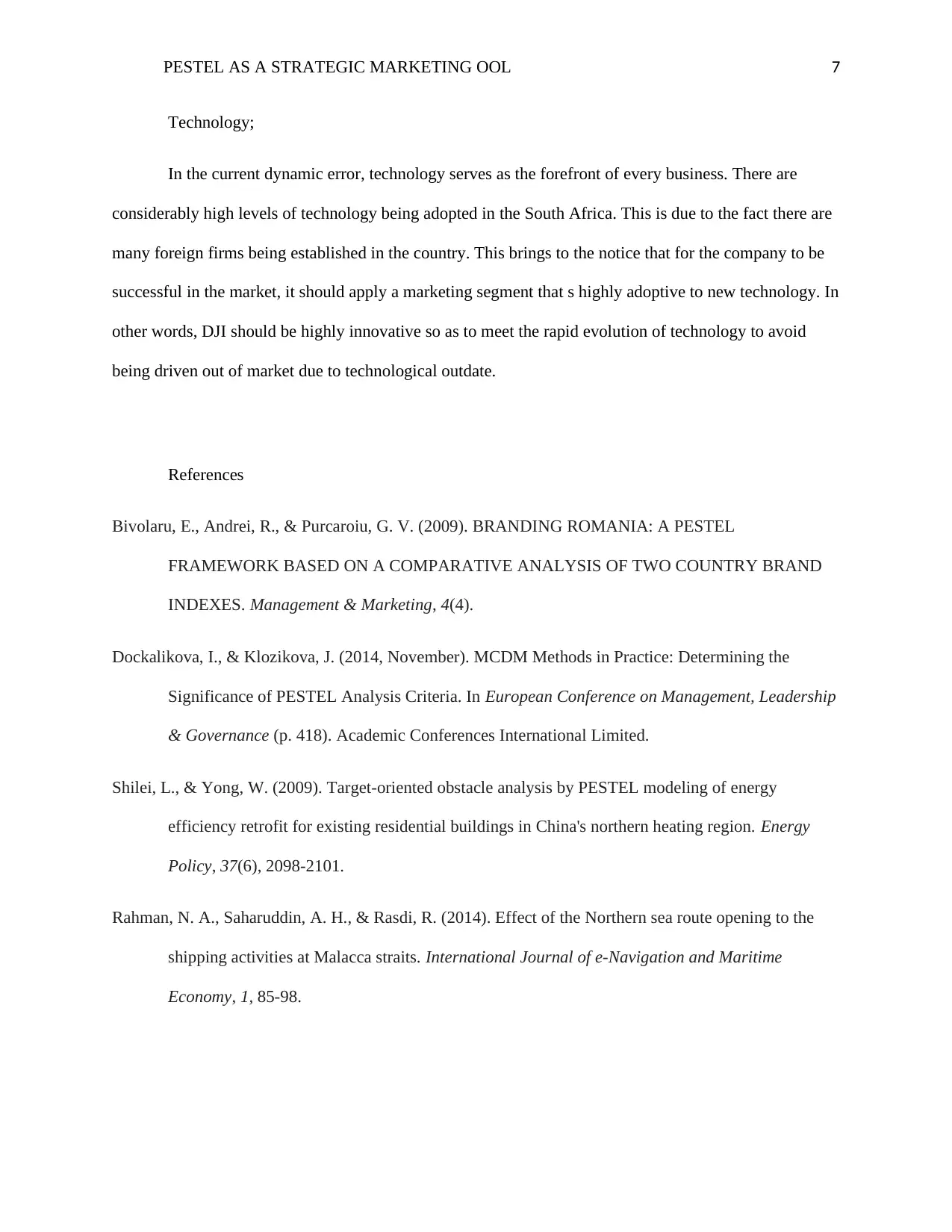
PESTEL AS A STRATEGIC MARKETING OOL 7
Technology;
In the current dynamic error, technology serves as the forefront of every business. There are
considerably high levels of technology being adopted in the South Africa. This is due to the fact there are
many foreign firms being established in the country. This brings to the notice that for the company to be
successful in the market, it should apply a marketing segment that s highly adoptive to new technology. In
other words, DJI should be highly innovative so as to meet the rapid evolution of technology to avoid
being driven out of market due to technological outdate.
References
Bivolaru, E., Andrei, R., & Purcaroiu, G. V. (2009). BRANDING ROMANIA: A PESTEL
FRAMEWORK BASED ON A COMPARATIVE ANALYSIS OF TWO COUNTRY BRAND
INDEXES. Management & Marketing, 4(4).
Dockalikova, I., & Klozikova, J. (2014, November). MCDM Methods in Practice: Determining the
Significance of PESTEL Analysis Criteria. In European Conference on Management, Leadership
& Governance (p. 418). Academic Conferences International Limited.
Shilei, L., & Yong, W. (2009). Target-oriented obstacle analysis by PESTEL modeling of energy
efficiency retrofit for existing residential buildings in China's northern heating region. Energy
Policy, 37(6), 2098-2101.
Rahman, N. A., Saharuddin, A. H., & Rasdi, R. (2014). Effect of the Northern sea route opening to the
shipping activities at Malacca straits. International Journal of e-Navigation and Maritime
Economy, 1, 85-98.
Technology;
In the current dynamic error, technology serves as the forefront of every business. There are
considerably high levels of technology being adopted in the South Africa. This is due to the fact there are
many foreign firms being established in the country. This brings to the notice that for the company to be
successful in the market, it should apply a marketing segment that s highly adoptive to new technology. In
other words, DJI should be highly innovative so as to meet the rapid evolution of technology to avoid
being driven out of market due to technological outdate.
References
Bivolaru, E., Andrei, R., & Purcaroiu, G. V. (2009). BRANDING ROMANIA: A PESTEL
FRAMEWORK BASED ON A COMPARATIVE ANALYSIS OF TWO COUNTRY BRAND
INDEXES. Management & Marketing, 4(4).
Dockalikova, I., & Klozikova, J. (2014, November). MCDM Methods in Practice: Determining the
Significance of PESTEL Analysis Criteria. In European Conference on Management, Leadership
& Governance (p. 418). Academic Conferences International Limited.
Shilei, L., & Yong, W. (2009). Target-oriented obstacle analysis by PESTEL modeling of energy
efficiency retrofit for existing residential buildings in China's northern heating region. Energy
Policy, 37(6), 2098-2101.
Rahman, N. A., Saharuddin, A. H., & Rasdi, R. (2014). Effect of the Northern sea route opening to the
shipping activities at Malacca straits. International Journal of e-Navigation and Maritime
Economy, 1, 85-98.
Paraphrase This Document
Need a fresh take? Get an instant paraphrase of this document with our AI Paraphraser
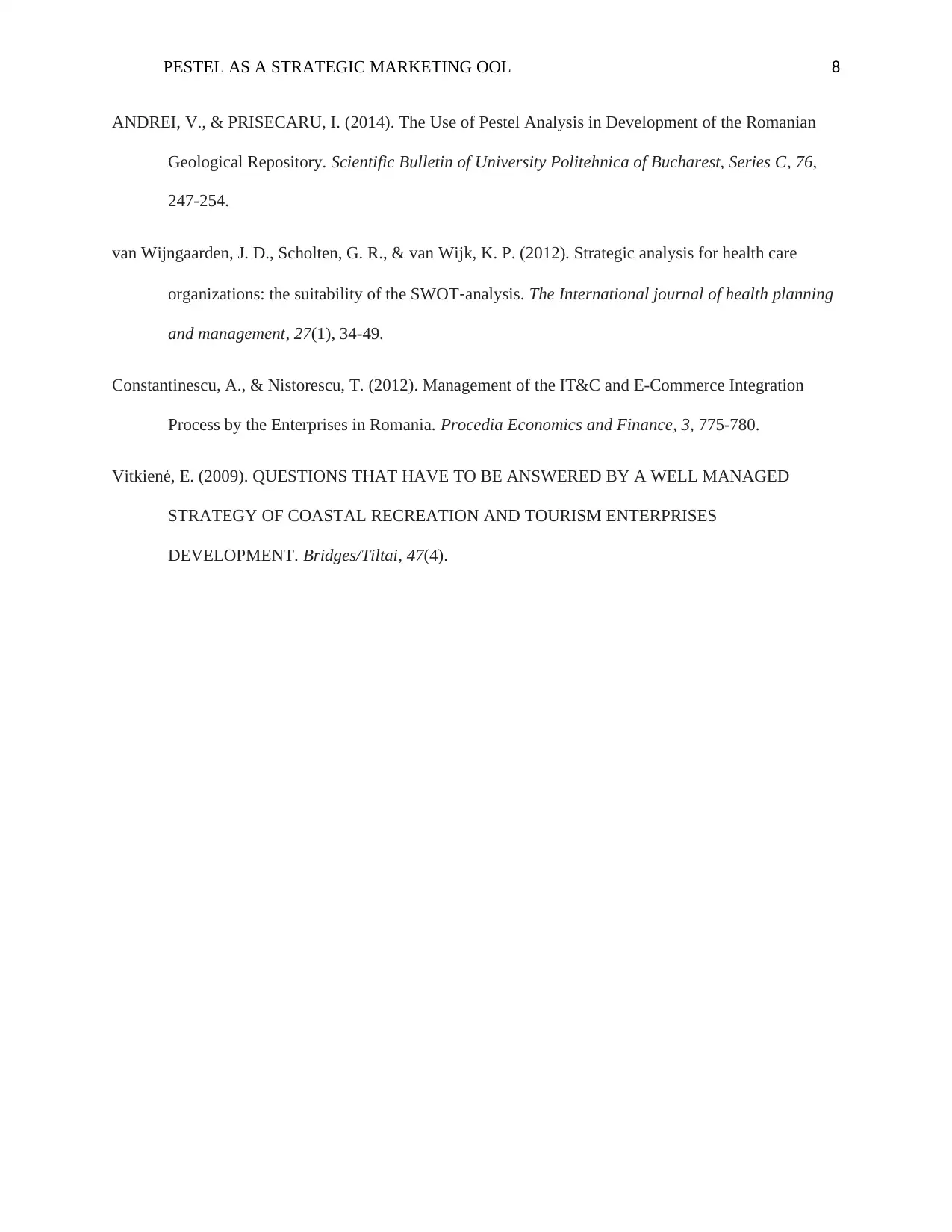
PESTEL AS A STRATEGIC MARKETING OOL 8
ANDREI, V., & PRISECARU, I. (2014). The Use of Pestel Analysis in Development of the Romanian
Geological Repository. Scientific Bulletin of University Politehnica of Bucharest, Series C, 76,
247-254.
van Wijngaarden, J. D., Scholten, G. R., & van Wijk, K. P. (2012). Strategic analysis for health care
organizations: the suitability of the SWOT‐analysis. The International journal of health planning
and management, 27(1), 34-49.
Constantinescu, A., & Nistorescu, T. (2012). Management of the IT&C and E-Commerce Integration
Process by the Enterprises in Romania. Procedia Economics and Finance, 3, 775-780.
Vitkienė, E. (2009). QUESTIONS THAT HAVE TO BE ANSWERED BY A WELL MANAGED
STRATEGY OF COASTAL RECREATION AND TOURISM ENTERPRISES
DEVELOPMENT. Bridges/Tiltai, 47(4).
ANDREI, V., & PRISECARU, I. (2014). The Use of Pestel Analysis in Development of the Romanian
Geological Repository. Scientific Bulletin of University Politehnica of Bucharest, Series C, 76,
247-254.
van Wijngaarden, J. D., Scholten, G. R., & van Wijk, K. P. (2012). Strategic analysis for health care
organizations: the suitability of the SWOT‐analysis. The International journal of health planning
and management, 27(1), 34-49.
Constantinescu, A., & Nistorescu, T. (2012). Management of the IT&C and E-Commerce Integration
Process by the Enterprises in Romania. Procedia Economics and Finance, 3, 775-780.
Vitkienė, E. (2009). QUESTIONS THAT HAVE TO BE ANSWERED BY A WELL MANAGED
STRATEGY OF COASTAL RECREATION AND TOURISM ENTERPRISES
DEVELOPMENT. Bridges/Tiltai, 47(4).
1 out of 8
Related Documents
Your All-in-One AI-Powered Toolkit for Academic Success.
+13062052269
info@desklib.com
Available 24*7 on WhatsApp / Email
![[object Object]](/_next/static/media/star-bottom.7253800d.svg)
Unlock your academic potential
© 2024 | Zucol Services PVT LTD | All rights reserved.



